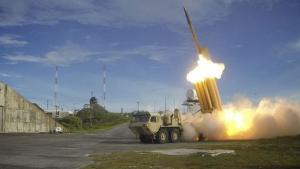
The U.S. military on Sunday hailed the success of a complex $230 million test of the U.S. missile defense system that it said showed the ability of the Aegis and THAAD weapons systems to identify and destroy ballistic and cruise missiles at once.
The test
was conducted near Wake Island in the western Pacific Ocean around
11:05 p.m. EDT by the U.S. Missile Defense Agency, U.S. European
Command, U.S. Pacific Command, the Ballistic Missile Defense System
Operational Test Agency and the Joint Functional Component Command for
Integrated Missile Defense.
"This
was a highly complex operational test of the BMDS which required all
elements to work together in an integrated layered defense design to
detect, track, discriminate, engage, and negate the ballistic missile
threats," MDA said in a statement released late Sunday.
"It's a huge success," Ellison said, adding the test would increase confidence in U.S. plans to deploy a THAAD battery, or system, to Europe, and could help support a drive to send a THAAD system to South Korea.
Critics often say tests of the missile defense system are too simple and do not simulate real-life potential threats.
The test involved a Terminal High Altitude Area Defense (THAAD) system built by Lockheed Martin Corp , two AN/TPY-2 radar systems built by Raytheon Co , Lockheed's Command, Control, Battle Management and Communications system, and the USS John Paul Jones destroyer with its AN/SPY-1 radar.
During the test, a THAAD system on Wake Island detected and destroyed a short-range target simulating a short-range ballistic missile that was launched by a C-17 transport plane.
At the same time, the THAAD system and the destroyer both launched missiles to intercept a medium range ballistic missile, launched by a second C-17. THAAD hit the target, but the Raytheon SM-3 Block IB missile failed early in its flight and missed.
MDA said it was investigating the problem.
Ellison said THAAD's ability to hit the second target showed the importance of having a layered missile defense system. "If one missile doesn't work, you have another system to use against enemy threats," he said.
While
the first two threats were being addressed, the Navy Aegis destroyer
also intercepted an BQM-74E target built by Northrop Grumman Corp using
a Standard Missile-2 Block IIIA guided missile.


No comments:
Post a Comment